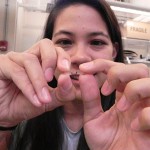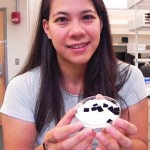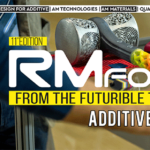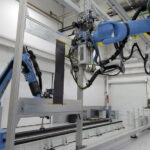Strenghtening aerospace laminates –
Sunny Wicks demonstrates toughening with aligned carbon nanotubes.
MIT doctoral student Sunny Wicks has made some surprising discoveries on the way to proving the case for enhancing aerospace laminate toughness by adding aligned carbon nanotubes.
“The more I work on this material, the more complex it gets,” Wicks, 28, said during a recent interview at MIT Associate Professor of Aeronautics and Astronautics Brian L. Wardle’s necst lab.
Fracture toughness studies of alumina-based CNT-reinforced laminates showed interlaminar reinforcement of laminates made with both marine and aerospace epoxies. But the results were not universal.
“The aligned nanotubes help to bridge together the layers of the composite so that any delamination crack has a tough time propagating between layers; essentially it takes more energy to tear them apart,” Wicks said. But results varied with the length of the carbon nanotubes and the type of polymer. “For the more brittle aerospace epoxy, short nanotubes actually drop the toughness all around, it almost halves the toughness; but then with marine epoxy, short CNTs still toughen the material 90 to 100 percent above the baseline. It’s sort of weird, but polymer type also dictates the sensitivity to nanotube length.
“So the take away is if you are trying to improve the toughness of a composite for a certain application, there are a lot of things that will influence the result, whether it’s a different type of epoxy or different kinds of polymers, those will play a role, so you can’t just make a blanket statement ‘I will improve your material by x percent.’ You can’t know that without knowing exactly how the polymer is interacting with the nanotubes; and its dependence on nanotube length. You can’t always tell why by just looking at the fracture surfaces, but if the CNTs in my typical laminates are on the order on 20 microns long, and I make them short, say 6 or 10 microns long, then what changes is the density of nanotubes in the polymer and also how the large fibers move apart, so it’s kind of a complex dependency,” she said.
Wicks won the American Institute of Aeronautics and Astronautics ( AIAA) Lockheed Martin Award for Best Structures paper for “Interlaminar Fracture Toughness of Laminated Woven Composites Reinforced with Aligned Nanoscale Fibers: Mechanisms at the Macro Micro and Nano Scales,” at the 54th AIAA Structures, Structural Dynamics, and Materials (SDM) Conference, in Boston in April 2013. Wardle co-authored the paper.
Fuzzy Fiber Plies
Wicks works with CNT-enhanced “fuzzy fiber” composites eight layers thick. “I start with the baseline composite with woven fabric in epoxy and I add the nanotubes to try to get the fracture toughness higher…By tearing apart the layers, you can determine whether the energy taken to tear them apart is higher.” She conducts Mode I fracture toughness tests with double cantilever beams of fuzzy-fiber reinforced laminate. Resulting samples show the crack sometimes jumps layers, an indication the carbon nanotubes force the crack to take a jagged rather than a straight-line route. (See related video.)
The aim is to improve materials for aircraft from unmanned aerial vehicles to commercial airplanes. However, the alumina-based test system would not end up in airplanes. “This is only the base system I use for demonstrating how nanotubes work in a composite. This would never be used in a structural component for an airplane because it’s not as stiff as carbon fiber. So carbon fiber will be the ultimate goal. Some of my other lab mates are working on growing (CNTs) on carbon fiber,” Wicks said. Graduate student Richard Li and postdoc Stephen Steiner published results of a study of CNTs grown on carbon-fiber in May 2013.
Wicks is working on fractures in small samples of CNTs embedded in epoxy bars and also manufacturing techniques for CNT-enhanced laminates. “We make a bar that has aligned nanotubes inside it, so the crack is forced to cut the nanotubes apart and propagate through this mini forest that we made,” she said. She forces a crack perpendicular to the nanotubes. Those results have not yet been published.
Descriptions of Wicks’ techniques for making fuzzy-fiber reinforced plastics were included in the Interlaminar Fracture Toughness paper. Aerospace epoxy, which is more watery in consistency, can be infused into the carbon nanotubes with a vacuum-assisted resin infusion set up, but the marine epoxy, which has a honey-like consistency, has to be applied by hand. It would harden too quickly in a vacuum apparatus.
Wicks, who is supported through a NASA Fellowship and the Linda and Richard (1958) Hardy Fellowship at MIT, spent a week and a half this July at NASA Goddard in Greenbelt, Md., outside Washington, D.C., where she collaborated with Justin Jones at NASA on small sample testing with a sensitive camera to study the strain field around the crack tip.
Wicks joined the necstlab as an undergraduate in 2005, receiving her B.S. at MIT in 2007 and her S.M. in 2010 in Aerospace Engineering. She hopes to complete her Ph.D. by the end of the year. After graduation, she would like to continue her research with NASA, a national lab or industry. “We’ll see how the economy is,” she said.
Fonte: MPC














